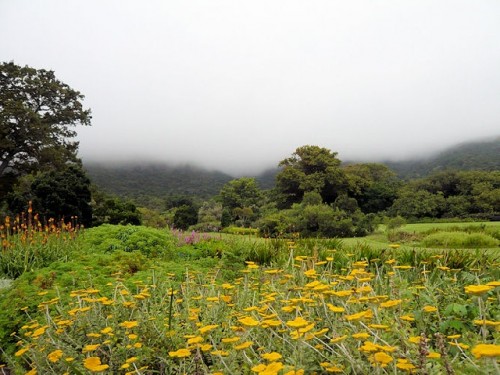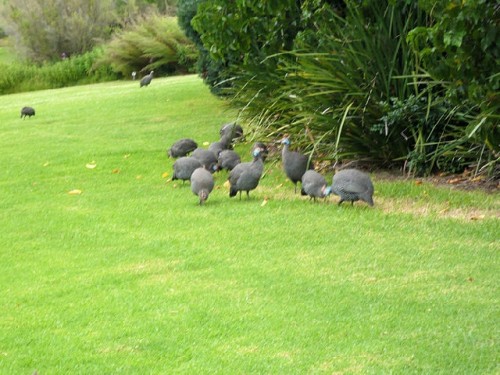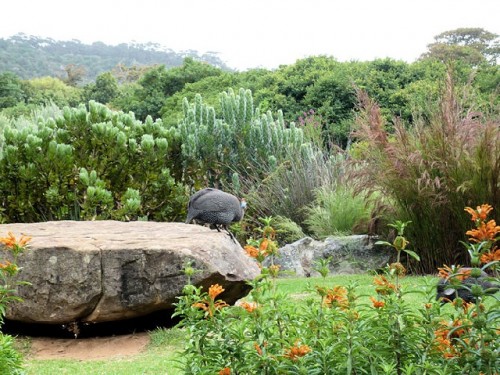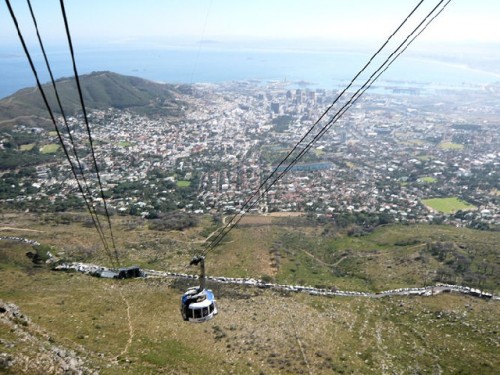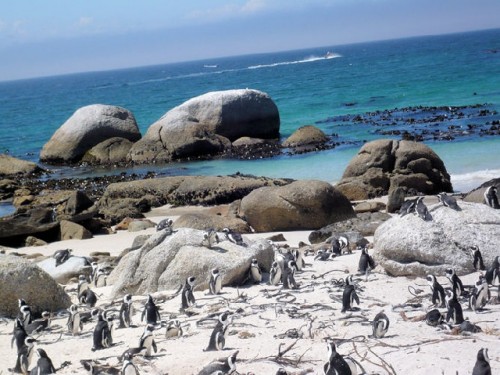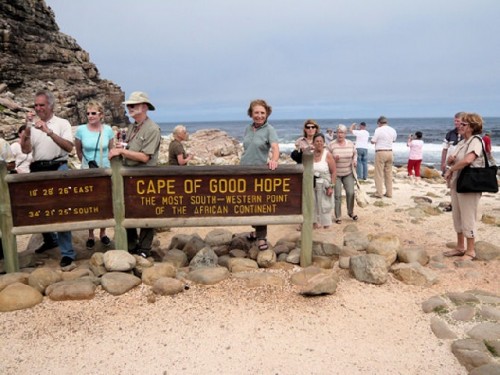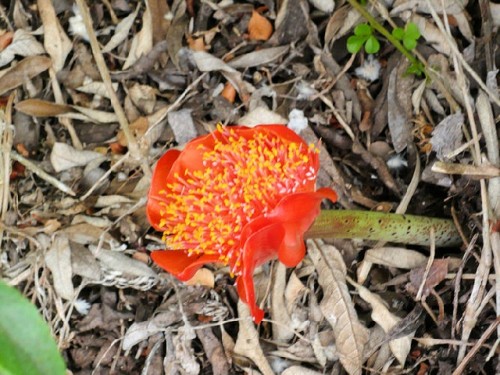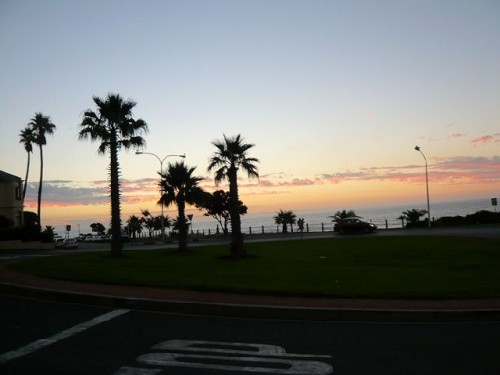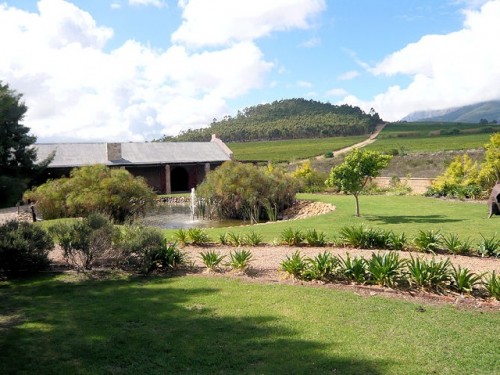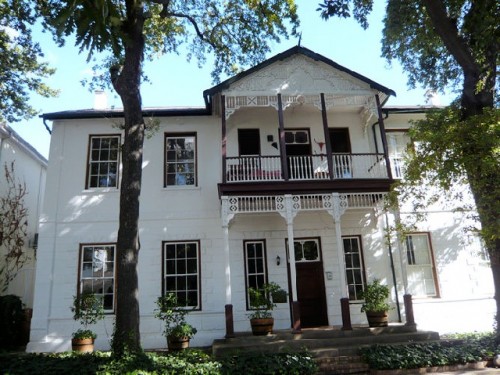Reports on Southern Africa: Part Six
Cape Town and Peninsula, South Africa
By: Zeren Earls - Apr 15, 2008
Nine of our full group of twelve continued on the post-trip extension to Cape Town. We arrived at our destination close to midnight due to a four-hour delay at Johannesburg airport. We were met by our new trip leader, Eric, a white South African of Danish origin. Since we had had a very long day traveling from Zimbabwe, I settled quickly in the hotel eager to go to sleep, only to realize the next morning that we had a view of the Atlantic Ocean from our window.
Cape Town and Peninsula sit on a mountain plateau flanked by the Atlantic and Indian Oceans. Our hotel, the Bantry Bay, was in Ocean Point, a picturesque suburb of Cape Town by the Atlantic Boardwalk, lined with palm trees. We started our day at the Kirstenbosch National Botanical Gardens on the eastern slope of Table Mountain. More than five thousand plant species are found in these gardens. We walked among the formally laid out beds of flora with brilliant colors and shapes against the backdrop of the mountain, shrouded in fog. Guinea hens with speckled feathers pecked on broad lawns; water lilies mirrored in ponds and cultivated pathways gave way to yellowwood forests. Browsing in the well-stocked book and gift shops completed our excursion.
Our visit to the diamond shop was informative about the journey of the gem from source to finished jewelry. Found in the ground as an angular stone, it is first cut in half with a thin piece of circular copper wire. Then it is further cut and faceted until light shines through and reflects. Size and cut determine the quality of the gem. We were also introduced to tanzanite, a gem found only in this part of the world; it is a beautiful grayish blue stone set in elegant jewelry.
A walk over the bridge from Clock Tower Square took us to The Victoria and Alfred Waterfront, where there is an array of restaurants. We had to use South African rand or credit cards to eat in the restaurants, and needed our passports to convert our money. Eric advised us to use credit cards for all purchases to get the best exchange rate. We ordered fish and ate on the patio of a busy restaurant. I ordered the grilled local butterfish, which was lost in translation, and arrived pan-fried. The optional tour to Robben Island was cancelled due to heavy winds. Located across the bay from Cape Town, the island was originally a penal colony for errant slaves, then a prison where Nelson Mandela and other anti-apartheid activists were kept. It is now protected as a nature reserve and its old jail buildings function as a museum dedicated to the struggle against apartheid.
The waterfront has been successfully developed into a tourist area. A bright red clock tower built around 1880 faces the harbor. Below the spectacular backdrop of Table Mountain, shops, craft markets, upscale hotels and pubs bustle with activity. Outdoor performers add local color to the mix. We browsed in and out of the shops; I bought bone napkin rings with stylized zebra patterns, a small basket and a T-shirt imprinted with Africa's big five: buffalo, elephant, lion, leopard and hippo. Back at Ocean Point, we walked around among the whitewashed modern homes with gardens and then joined spectators for the sunset over the Atlantic. As beautiful as the ocean is, it is chilly for swimming and full of kelp. Instead of eating the kelp, South Africans export it to Japan.
The next morning based on a forecast for wind-free weather, we went up Table Mountain, the famous 1085-meter high flat-topped sandstone mountain visible from all directions. There were long lines at the cable car station, but they moved quickly, since each of the two cars held 65 people. Our cable car journey, about six minutes long, provided a 360 degree panoramic view, thanks to the turning floor. We enjoyed views of the city and coastline from the top and walked around the mountain's rocky terrain, admiring flowers, including blue orchids, pushing out between boulders.
Our next destination was the Cape of Good Hope Nature Reserve. We followed the coastal route south and then cut across the peninsula, passing Fish Hoek and stopping along the False Bay coastline to see the penguin colony at Boulders Beach. Coming upon hundreds of penguins burrowed in sand or resting on boulders was an unforgettable sight. With their distinctive black and white coloring, they were like little statues sitting in sand holes alone or in pairs. The African or black-footed penguins in this colony are a warm- weather species; they rest during the day and are active at night.
Our lunch stop was at the Black Marlin Seafood Restaurant in Simon's Town, north of Boulder Beach. The specialty of the house was "fish on a spit". Chunks of grilled fish of our choice came on a skewer hanging from a metal stand and were placed in front of us behind our plates. This is a clever idea that allows one to help oneself when ready for each chunk and not have the skewer sitting on the plate with the accompanying rice and steamed vegetables. A green salad, whole-grain bread and ice cream for dessert completed our delicious lunch.
Following a winding road with wonderful views down to the sea, we reached the Cape of Good Hope Nature Reserve. This southernmost point on the peninsula with wild scrubland, baboons, and ocean views was teeming with international tourists speaking many tongues. From here a stiff uphill walk, as the funicular train was not in service, led us to the old cliff-top lighthouse at Cape Point, a dangerous spot for ships, where currents from the Indian and Atlantic Oceans meet. Fogged in, we could not enjoy the view below. Back on the road we snaked upwards, enjoying scenic views, which included scorched landscapes with red flowers. Fires start due to heat combustion and are put out by water bombs from helicopters. Fed by nutrients in the charred detritus, flowers pop up after fires.
On the ride back, Eric talked about South Africa from a white man's perspective. Cape Town is a predominantly white city of four million people, one million of whom live in informal settlements, our guide's term for shanty towns outside the city. When apartheid ended, blacks arrived from the east for job opportunities. The ANC gave them land, mostly "to collect votes". The municipality provides electricity and plumbing for the stacked up barracks. People are divided into three types; white, colored and black, a classification coined by the English occupiers. The coloreds are descendants of slaves from Africa and East Asia who had relations with Dutch farmers. The Malays from East Asia have high cheek bones and almond eyes. The blacks are from the bush, constitute the poorest of the three classes, and are looked down by the coloreds.
The next day, we traveled east of Cape Town to the wine country and the heart of Cape Dutch culture. The scenery included rolling hills, beautiful farms, and dramatic mountain vistas. We visited two wine estates; the first was Anura Vineyards. After tasting seven kinds of wine and a sampling of cheeses and pate, we had a behind-the-scenes-tour of wine production. Grapes are hand-picked to guarantee quality, and then crushed with their skins for red wine. They are fermented with yeast and aged in oak barrels for different periods of time before the wine is bottled and corked. The barrels are imported from France or the United States, as South African oak is too porous because of the climate.
The second estate was on the Solms Delta situated along the eastern banks of the Dwars River. The estate's vineyards, surrounded by towering mountains, are exclusively Rhone varietals, which do well in the temperate climate with its long hot summers and mild winters. We tasted five different wines and then visited the estate's Van De Caab Museum, which told the story of the farm from its early Stone Age inhabitants to herders, European traders, colonization, slavery, emancipation, and finally democracy. Amazingly the entire history of South Africa had been compressed into this graceful farmland. The current white owners of the farm have established a trust, which receives 50% of all profits generated by the wines. Its beneficiaries are the historically disadvantaged residents and employees of the Delta, as well as the wider rural community.
Next on our itinerary was Franschoek, meaning "French corner", in reference to the Huguenots, the Protestant refugees persecuted by Louis XIV for their religious beliefs, who settled here in the eighteenth century. This was a charming town with historic buildings, pricey elegant shops and many al fresco restaurants, eight of which are listed in the country's top 100. I spent the lunch hour walking around to see as much as I could. Our second port of call was Stellenbosch, an architectural jewel founded in 1679, 30 kilometers east of Cape Town. All historic buildings have been restored and designated as heritage sites. The town is known for its university, the first Afrikaans-language institution of higher education to have been established, and for its large number of Cape Dutch houses, distinguished by their windows divided into small squares and oak trees.
In the evening we had a home-hosted dinner at the home of a middle-class colored family. We met the grandmother, the daughter-in-law, her fourteen-year-old twin boys and her two-year-old daughter. The men were away at work. We had a glass of wine and samosas in the sitting room with television and family photos nearby, and framed bird pictures on the wall. Then we moved to the dining table for a meal of local cuisine: bobotie, a sweet and spicy dish of ground meat and rice, carrots, peas and beets, as well as cake with custard sauce. A black woman, who was a neighbor's house keeper, came over to do the dishes. The conversation mostly centered on the difficulties of daily life in South Africa.
During free time on our final day, we went to the historic Cape Town by minivan, which left when full. From bustling Adderly Street, we walked to the Company's Gardens, peacefully set with grand buildings housing various museums. Tucked in a secluded corner is the Anglican St. George's Cathedral, the former diocese of Nobel laureate Desmond Tutu. Dominating the area are the Houses of Parliament built in High Victorian style. The South African National Gallery is mainly a collection of Western art built up during the apartheid era; current acquisitions favor indigenous art. We viewed a special exhibition of African crafts and a compelling photo exhibition of apartheid days.
The museum shop had remarkable crafts made by women in townships, organized by project, with assistance from designers. In addition to crafts deeply rooted in the ancient tribal skills, such as wooden sculpture, pottery and beadwork, the museum also had unique contemporary crafts: paper mache bowls from recycled paper and candle holders from colorful twisted telephone wires, to name a few. Their sale helps generate income for the women and empower those with HIV/AIDS to take control of their lives.
Cape Town has numerous museums relating to various aspects of its colorful past; most operate under the umbrella of Iziko Museums of Cape Town. The Iziko South African Museum houses a wide variety of cultural and natural history displays, among them a superb collection of rock art that has been removed from its natural setting. Paintings and engravings, cradles of African expression, depict the San people, who were inspired by beliefs about the spirit world, rain-making and healing. The Iziko Slave Lodge is a building that was originally constructed to house the slaves of the Dutch East India Company. It is one of the oldest seventeenth-century buildings built and occupied by slaves, who came from Angola, Mozambique, India and the Indonesian islands to Cape Town. The building contains archeological deposits, original artifacts, and objects used by the slaves.
Visiting the Slave Lodge was a poignant ending to our trip. It reminded me once again of this young nation's suffocating history and its refusal to be silenced. Since the evil of apartheid ended only fourteen years ago, the country's struggle with the messy and complex processes of an evolving democracy is understandable.
At the airport I stood in line to recover the sales tax for my purchases, only to turn around and spend it on crafts that were a tribute to Africa's long tradition of visual expression with bold forms, vibrant colors and joy in creation.

